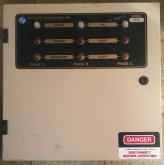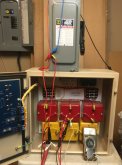I read somewhere that you should have one at the first possible point in the system, which would be the combiner box for me. That makes sense to me-why not stop the surge as early as possible to protect things downstream. I don't know, I guess I have a lot more reading to do.
Yes, clamping early is good, and a path to to earth out at the PV array is good. That leaves a longer wire run back to your equipment; resistance and inductance will attenuate the remaining surge so additional devices in the equipment protects it.
You could install another commercial arrestor (or just a varistor) at your equipment. Some of my Sunny Boys have DC and/or AC varistors in their disconnect switch. I plan to add more back in the combiner (where I presently have Delta "arrestors", which I don't think are good as anything except a spark gap for lightning; could get them to fire all the way up to 5 kV)
To me, buying the Midnight unit doesn't feel like DIY, so I was selecting varistors and parts to make status LEDs. But then I found a new old-stock unit on eBay and bought it for the AC side.
Too much capacitance for my HyPot (reactive current charging capacitor at 60 Hz exceeds 1 mA threshold), so I used the diode and capacitor from a microwave oven, gradually charged it up adjusting HyPot voltage until it reached 600 VDC. Then I threw a switch dumping that into the arrestor. All three phases clamped at 200V.
This unit has indicator lights, and two banks of varistors - after the lower voltage ones blow a second set is waiting in the wings. Lights show which are still good, and dry contacts make status available for remote monitoring. I haven't opened the cans, don't know how many kA or J it can handle, but I ain't worried anymore (on the AC side.)









